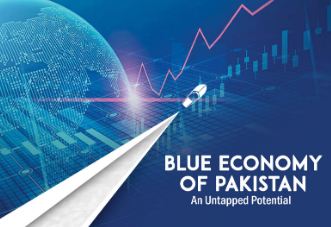Commander Anees Muhammad Khan (RTD)
Maritime is generally referred to as any activity which concerns oceans and seas. When coupled with economics, it obviously means all activities which generate or facilitate economic development in one way or the other through uses of oceans and seas. The great USA Maritime Strategist Alfred Thayer Mahan has very rightly said that ‘Greatness and strengths of the nations is the product of wealth, derived from sea and trade”. Maritime Economy is also generally referred, although wrongly, as Blue Economy since Maritime Economy in itself is a part of Blue Economy and not exclusively represent Blue Economy. The term Blue Resources is also occasionally associated with Blue Economy due sea, oceans, rivers etc. It’s but obvious that Blue economy flourishes in proportion to the maritime sector investment of any country with particular reference to its security spectrum.
The development of the Blue Economy contemporary model is of paramount importance to Pakistan, with over 90% of its trade and fuel imports relying on maritime routes. If fully developed, it could yield substantial financial benefits by 2030-2035, with projected revenues of $8-10 billion from shipping, $7-8 billion from fisheries, upto $10 billion from aquaculture, up to $20 billion from CPEC, $5-6 billion from Maritime Tourism, upto $10 billion from Renewable Energy Projects, $2-3 billion from Ship Recycling Industry at Gadani, and $6-8 billion from transforming Ports and Harbor’s into Environmentally friendly so called Green Ports. Presently, the Blue Economy contributes between 1.5% and 3% to the Pakistan’s GDP, but this could increase to 10% to 15% through strategic development of this sector & subsequent tactical level execution.
It is pertinent to highlight that Regional countries with almost same resources and constraints as Pakistan are fetching the dividends of this sector. Bangladesh & India are earning $6-8 billion and $7-10 billion annually respectively. However, Pakistan is still lagging behind than its true potential. Pakistan Vision Document 2025 also does not dwell much on development of Blue Economy.
Although, with the development of Gwadar port with its peculiar geographical location coupled with China Pakistan Economic Corridor (CPEC) projects, a renewed focus on the Government level has been given to explore this sector to the fullest eyeing capitalizing upto $ 60 Billion CPEC projects with Gwadar and North Arabian Sea (NAS)as its center stage. Renewed focus on this sector can also be gauged from the fact that year 2020 was declared as the ‘Year of Blue Economy’ by the Government of Pakistan. Food Processing, Exclusive Economic Zone (EEZ) exploration, Liquid Petroleum Gas (LPG) & Liquid Nitrogen Gas (LNG) Terminals, Coastal Development & Shipping industry uplift were included for improvement. However, inspite of passing of four years, it has not been able to make any practical impact in improving this sector due numerous manageable factors. In Shipping Industry, for example, for last two decades, no new Ship has been registered. This is in contrast to the thriving shipping industry of country in 1970s.
Notwithstanding, Pakistan has lot of potential in development of its maritime sector. With its over 100 km coast line and beautiful beaches, Maritime tourism development is one such avenue which needs to be developed & explored through Public-Private Partnership in Sindh & Balochistan province. It’s heartening that private sector is now investing in this field. Local companies are taking tourist to Ormara beaches in Balochistan and local ferries are being considered for furthering maritime tourism in Karachi. These all are good omens, however, they need continued government support for obvious reasons for long term continuity.
About the potential of EEZ in under water mineral exploration, international experts believe that one Square Mile of sea bed, in any part of the world, may be covered with 70000 tons of minerals including manganese, aluminum, cadmium, iron, cobalt, nickel, copper worth Billions of dollars financial worth in the open market. About hydrocarbon, it requires continued efforts. In a comparatively recent attempt for its exploration in January 2019 by Oil and Gas Development Corporation (OGDCL), Sui Southern Gas Company (SSGC) and ExxonMobil, whereby 5500 meter deep drilling was conducted in the Indus Basin however it could not succeed. However, the EEZ of Pakistan needs continuous exploration since it yields dividends sometime in hundreds of attempts. Norway for example succeeded in its 78th attempt in its own EEZ.
Blue Economy models are contemporary and need to be understood and implemented in Pakistan. First and foremost is the true understanding of the potential of this sector. Subsequently, National Maritime Policy be implemented while cognizant of the ground contemporary realities since its last revision in 2001-02. Blue Economy concept has emerged from 2010 onward and Pakistan is involved in CPEC since 2015. These two new avenues need to be incorporated in the policy document and then be promulgated. It be then followed by a development of a hierarchical system of sector through setting up of a National Maritime Authority in line with the guidance and charter in the Policy Document. National Maritime Authority shall be a wholesome body consisting of all stakeholders including maritime sector which shall then oversee the same. It will need all stakeholders and require a comprehensive approach which shall cater for maritime security, governance, law and above all sustainability of resources in Pakistan’s EEZ so to ensure that maritime economy is developed in line with modern concept of Blue Economy. If done, Pakistan would be an economically self-sufficient state by year 2030.

















